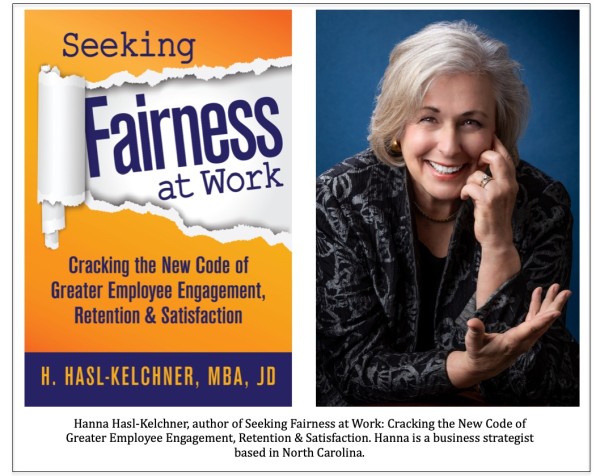The following is an excerpt of the new book, Seeking Fairness at Work… Cracking the New Code of Greater Employee Engagement, Retention and Satisfaction. The book was authored by Hanna Hasl-Kelchner. Hanna is a business strategist, host of the Business Confidential Now podcast, and President of Business M.O., LLC.

Fairness is a universal human value that transcends cultures around the world. Unfairness at work is demoralizing and is an especially toxic stressor because it attacks us personally according to Dr. E. Kevin Kelloway, Canada Research Chair in Occupational Health Psychology at Saint Mary’s University. It’s an affront to our dignity and core identity. And, as a toxic stressor, its impact can be felt far beyond momentary emotional stress and lead to serious physical symptoms. It attacks who we are, and when we’re under assault, our bodies get flooded with adrenaline and stress hormones such as cortisol.
Cortisol can wreak serious havoc. If we suddenly find ourselves experiencing frequent upset stomachs that our doctor later concludes is acid reflux, we can probably thank cortisol. Experiencing weight gain? We probably can thank cortisol for that one too. Its impact is felt on our thyroid gland where it slows down our metabolism and on our adrenal glands where it can increase our hunger. Comfort foods high in fat and sugar content can temporarily make us feel better but tip the scales in an unhealthy direction. Cortisol’s impact on the adrenal glands can also decrease our drives. So, between unhealthy weight gain and strained personal relationships it’s common to feel depressed. Stress can even affect the body at the cellular level, weathering us from the inside out and contributing to premature signs of aging. Great, huh?
Weekends provide a welcome respite from workplace stress and opportunity to recharge. But the relief is short-lived. On Sunday afternoon our stomachs are in knots as we steel ourselves for the work week ahead. It’s a phenomenon dubbed the “Sunday Scaries,” and a survey commissioned by LinkedIn, the world’s largest professional online network, discovered 80% of working adults experience it. So, while we may not be alone in suffering, it’s a soul-crushing club we didn’t particularly want to join; but one we may feel stuck in. It’s no wonder employee engagement rates fluctuate within narrow bands in Gallup reports and surveys from year to year.
The Value of High Employee Engagement
Definitions of employee engagement vary depending on the source. The central idea is that when workers feel fairly supported to do their best work, when they are included and feel like they belong, they bring an extra degree of energy and discretionary effort to the table because they’re more emotionally and intellectually committed. What they do matters. They matter. Their commitment to the organization therefore goes far beyond just showing up for work and robotically meeting job requirements in exchange for a paycheck. They feel empowered and inspired to go above and beyond the call of duty.
Employee engagement is incredibly powerful. Organizations vigorously pursue it because research shows those with a highly engaged workforce experience:
• 2.6 times higher earnings-per-share,
• double the net income,
• seven times greater 5-year total annual shareholder return,
• 19.2% higher growth in annual operating income,
• triple the profit growth compared to competitors,
• double the customer loyalty and employee productivity; and
• 87% less employee attrition.
Those are impressive numbers.
The Huge Cost of Low Employee Engagement
In contrast, and in addition to the physical and emotional cost to employees on both sides of the desk, organizations with low employee engagement miss out on its benefits and get penalized with 37% more absenteeism and lost productivity. Gallup estimates it costs employers $3,400 for every $10,000 a disengaged employee earns. In other words, it’s a productivity penalty of 34% of their annual pay. Multiply that by the number of disengaged employees on a payroll, and the out-of-pocket opportunity cost adds up fast.

There is also a high correlation between employee engagement and retention. Research shows that there is a 48% chance that employees with low engagement will quit, making it a gateway to employee turnover. While managers may be willing to take that risk, believing they could reclaim some lost productivity with eager new hires, the reality isn’t so rosy. Organizations are really swapping a large expense for an even bigger one.
The hiring and training cost of replacing an employee is between 30-50% of their annual salary at the entry level and up to 400% at the most senior ranks. What makes that turnover price tag deceptive is how it fails to include collateral damage resulting from coworkers who now have to work harder and longer in the interim, with the extra workload potentially contributing to their burnout. It also ignores the loss of valuable information, such as institutional knowledge when long-term employees leave, or the potential loss of proprietary information (absent a confidentiality agreement).
Other costs include hiccups in established business relationships when a customer-facing employee quits and lost revenue if they’re able to transition customers to their new employer or start-up. Departing employees can also inspire those left behind to start looking for new positions, causing an even bigger exodus.
Worst of all is how employee churn destabilizes business operations. It keeps teams from gelling. It distracts leadership with a continuous recruiting process. It compromises the remaining employees’ willingness and ability to learn new things because they’re strapped for time doing extra work, and it kills momentum by chewing up resources that could otherwise be spent moving the business forward.
Meanwhile, disengaged employees who stay on the payroll can infect the organization’s culture with their halfhearted approach and hamper performance because they’re more likely to miss deadlines, goals, and sales targets. They also contribute to increased customer complaints and workers’ compensation, harassment, and discrimination claims, and keep potential legal problems buried until they’re too big to hide, at which point they’re also more expensive to fix.
It gets potentially worse when employee dissatisfaction stems from mismanagement of a legal or an ethical issue, turning disgruntled workers into whistleblowers. Public disclosures can cause a firestorm of unwanted media attention, creating legal liability and reputation damage for individual managers and the organization as a whole.
Yet one of the most overlooked and distressing disengagement landmines is the connection to workplace violence. Disengaged employees are more likely to feel more stressed, worried, and angrier than their engaged peers. It sets the stage for conflict that can easily spill into threatening behaviors such as bullying, harassment, retaliation, or physical altercations.
Altogether, the financial and psychological toll of low employee engagement on the workplace is enormous.
The Urgent Need for Change
Evolving employee priorities are colliding with traditional command-and-control style management that tends to view hiring its workforce transactionally, managing them with positional power and an emphasis on bottom-line metrics, rather than people-focused, relationship-building strategies. Simply put: old-school management isn’t meeting new-school needs. It’s a standoff that won’t improve until managers understand why employees respond negatively to workplace culture and appreciate how low employee engagement, satisfaction, and retention are symptoms of a suboptimal culture, one that management controls and can change.
Leadership matters. Workers change jobs because they leave their manager, not the company. Indeed, the quality of supervisory personnel is the single biggest factor in job change decisions according to the book It’s the Manager. Other research finds 75% of employees think their direct manager is the most stressful part of the job, and 65% say they’d rather have a new manager than a pay raise.
Ouch!
It’s against this backdrop of workplace discontent, including a staggering 59% of workers being disengaged, or “quiet quitting” in Gallup’s 2023 parlance, and another 18% being actively disengaged, or just plain miserable at work and “loud quitting,” that Seeking Fairness at Work begins.
As a business strategist and attorney, frustrated employees have shared their feelings of helplessness and anger with me many times over the years. They were upset about the organization’s willful blindness to management behaviors that torched their dignity, confidence, and psychological safety. When raising a serious issue about the behavior of a senior vice president with the head of human resources at a large manufacturing company, for example, an employee was essentially shooed away. “It’s worse in other departments,” they were told. In desperation, they consulted a lawyer.
This story is but a small sample of the misguided leadership behaviors I’ve witnessed over the years that damage trust and result in unintended negative consequences. No, they didn’t always trigger lawsuits. Although, many could have. But they were always costly in terms of diminished employee engagement, retention, and definitely satisfaction.
Read more in the new book available where books are sold.
Hanna Hasl-Kelchner is the author of Seeking Fairness at Work: Cracking the New Code of Greater Employee Engagement, Retention & Satisfaction. She helps organizations gain clarity to make more informed decisions by reducing complex concepts into sensible, bite size pieces. Hanna accomplishes this as a business strategist and President of Business M.O., LLC; through her writing, speaking, consulting, and popular syndicated podcast, Business Confidential Now. Follow Hanna on LinkedIn, Twitter, and YouTube.
Follow Hanna’s Work. Website: https://www.SeekingFairnessAtWork.com
Available for Media Interviews.
Contact: Jo Allison
Phone: 917-207-1039
Email: Jo@MediaAmbassadors.com
Website: http://www.MediaAmbassadors.com
Or, Contact Hanna Hasl-Kelchner directly.
Email: Hanna @ businessmo.com
Media Contact
Company Name: Media Ambassadors
Contact Person: Jo Allison
Email: Send Email
Country: United States
Website: https://www.MediaAmbassadors.com